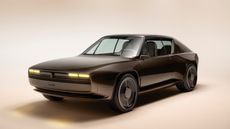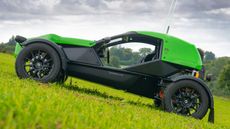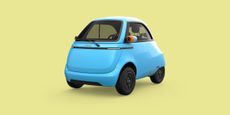We take Audi’s new Q6 e-tron quattro around and across the fjords of Norway
The new Audi Q6 e-tron quattro is a pure EV that marks a new design direction for the German brand, setting new tech standards along the way. Transportation Editor, Jonathan Bell, takes it for a drive

Launched during this year’s Milan Design Week, the new Audi Q6 e-tron marks the start of Audi’s next generation line-up of EVs. The company’s first forays into the world of electrification were leftfield and thrilling. The original e-tron from 2009 was effectively an electrified R8, and it was followed by several other concepts bearing the e-tron name. These were the very early years of EVs, and there followed a general loss of nerve across the industry, compounded by a total absence of a Europe-wide charging network, and a lack of strong government incentives to both manufacturers and customers.

Audi Q6 e-tron
It wasn’t until 2018’s e-tron (later renamed the Audi Q8 e-tron) that the company’s EV programme started in earnest. In a piece of inverse evolution, it turned out that the best way to build an EV was to start big. Audi wasn’t the only legacy manufacturer thinking this way; Mercedes also fielded an SUV as its debut electric vehicle. Hence we find ourselves in a paradoxical world awash with heavy, bulky electric SUVs, at a time when light and compact cars are increasingly seen as the only socially acceptable way to preserve the practical benefits of personal mobility, in European cities at least. Only China has really doubled down on building small EVs alongside bigger ones, a focus that may yet come to bite Western car makers hard.

Audi Q6 e-tron
This is a long-winded way of explaining how we wound up in Norway driving the Audi Q6 e-tron quattro. The country is a world leader in automotive electrification (despite having no significant car industry of its own), and Audi clearly feels that it's the best place to demonstrate EV life. The launch of this mid-size electric SUV has come shortly after the German brand shuffled its deck of model names, dropping some familiar badges in an effort to create a more cohesive structure – Audi ‘A’s are still saloons and estates, ‘Q’ models are SUVs, with the A4 line-up becoming the A5 line-up in a seemingly arbitrary shift.

Audi Q6 e-tron
Underneath the Q6 e-tron is the Premium Platform Electric (PPE), the VW Group’s newly developed, ultra-flexible electrical architecture that will underpin reams of new models across its brand portfolio over the next few years and already forms the basis of Porsche’s Macan EV. It’ll also be used in the forthcoming A6 e-tron saloon and estate, due later this year. As only the second electric Audi to be designed as ground-up EV (after the flagship e-tron GT), the Q6 incorporates a huge number of efficiencies.

The Audi Q6 e-tron's multi-screened dashboard
Audi’s Jessica Martin, Product Manager for the Q6 e-tron, told us that the car represented ‘a first for the brand in so many ways,’ adding that there were 'so many benefits with PPE,’ not least the electrical architecture’s ability to fast charge (10 to 80 % charge in just 20 minutes at 270kW), a new integrated electronics architecture that streamlines the multiple systems required for a modern EV, and other innovations like Audi’s own AI assistant (what we used to call ‘voice recognition’), capable of understanding up to 800 commands. The headline stat is a range of 381 miles, giving plenty of reserves for day to day driving without the dread encroachment of range anxiety.

Audi Q6 e-tron interior details
The Q6 also marks the debut of a new Audi interior design language, through which the company is hoping to recapture some of the glory days of the noughties when its interiors reigned supreme. Although interior quality and materials are impeccable, the actual arrangement of screens across the dash, from binnacle to central display to passenger screen, feels a bit awkward, a sprawl of pixel real estate that looks like a collision of angles and forms.

Information overload: the Audi Q6 e-tron has an additional screen for the passenger
The software and graphics are also largely excellent, as is the equipment levels on this fully stacked ‘edition 1’ launch model. These include adaptive cruise control, a panoramic roof, adaptive air suspension, a digital key, and speakers embedded in the driver’s headrest to give nav info without disturbing the other passengers. All this is luxury has been squeezed into what would once have been considered a standard family car, with a corresponding uplift in price. Space is generous, with no transmission tunnel, and high-quality materials include Napa leather. In addition to the passenger screen, which controls music, ventilation and mapping, there are also ‘smart’ panels on the doors and an informative head-up display.
Wallpaper* Newsletter
Receive our daily digest of inspiration, escapism and design stories from around the world direct to your inbox.

Audi Q6 e-tron rear seats
Outside, the Q6 follows the accepted playbook of contemporary SUV design – Audi hasn’t yet gone down the path of intermediate style and size crossover models. From the side and rear it’s inoffensive and well-proportioned, with flared rear wheel arches (dubbed ‘quattro blisters’ in homage to the iconic 80s rally car and also referencing the handsome e-tron GT) and a black inset side panel indicating the location of the battery pack. The front end is less successful, with the demands of branding, sensors, lighting and aerodynamics fighting it out for space with no overall winner. The lights are particularly impressive, being active and digital, offering up different designs and the ability to personalise the light signature front and rear.

Audi Q6 e-tron
Driving through the beautiful but rigorously policed roads of Norway, the Q6 e-tron was a trusted and smooth companion. It’s no out-and-out performer, but the car deploys its electrical shove when necessary and the steering feels precise and well-weighted. Excellent ride quality soaks up the weight of the battery and any road imperfections – Audis no longer have the brutally hard suspension they did in the past. In terms of range, feel and practicality, the Q6 can’t really be faulted; the only issues are style and size. Both quibbles could be quashed by the upcoming A6 e-tron Avant, the arrival of which is a marginally more tempting prospect for fans of Audi’s famous streak of trend-setting styling from the 90s onwards.

The interior offers plenty of space
For now, the Q6 e-tron will do Audi fans just nicely, even though challengers are already lining up. As the Norway fleet of press Q6s parked up outside the Bergen Børs Hotel, an Xpeng G9 glides past, one of many models from Chinese firms finding increasing favour in Europe. It looks a little cleaner and simpler and is certainly cheaper. Voted "People's Favourite" in Norway’s Dagbladet newspaper’s Car of the Year 2024 awards, the G9 is a stark reminder of how quickly things are changing in the EV world, a far cry from the slow ramp-up of the last decade. Audi will need to move fast to keep up.

Audi Q6 e-tron
Audi Q6 e-tron quattro, from £63,000, launch edition, £84,000 launch edition, Audi.co.uk
Jonathan Bell has written for Wallpaper* magazine since 1999, covering everything from architecture and transport design to books, tech and graphic design. He is now the magazine’s Transport and Technology Editor. Jonathan has written and edited 15 books, including Concept Car Design, 21st Century House, and The New Modern House. He is also the host of Wallpaper’s first podcast.
-
 Three new coffee makers for a contemporary brew, from a casual cup to a full-on branded espresso
Three new coffee makers for a contemporary brew, from a casual cup to a full-on branded espressoThree new coffee makers, from AeroPress, Jura and Porsche x La Marzocco, range from the defiantly manual to the bells and whistles of a traditional countertop espresso machine
By Jonathan Bell Published
-
 Don't miss Luxembourg's retro-futuristic lab pavilion in Venice
Don't miss Luxembourg's retro-futuristic lab pavilion in VeniceAs the Venice Biennale enters its last few weeks, catch 'A Comparative Dialogue Act' at the Luxembourg Pavilion
By Amah-Rose Abrams Published
-
 A Berlin park atop an office building offers a new model of urban landscaping
A Berlin park atop an office building offers a new model of urban landscapingA Berlin park and office space by Grüntuch Ernst Architeken offer a symbiotic relationship between urban design and green living materials
By Michael Webb Published
-
 All hail the arrival of true autonomy? On Tesla’s proposed Robotaxi and techno-insecurity
All hail the arrival of true autonomy? On Tesla’s proposed Robotaxi and techno-insecurityTesla’s new marketing push predicts a future of robot cabs, automated buses and autonomous home androids. We already want to get off
By Jonathan Bell Published
-
 We report from the theatrical, laser-lit launch of Lynk & Co’s first European EV, the 02
We report from the theatrical, laser-lit launch of Lynk & Co’s first European EV, the 02In the future, will we treat cars like streaming services and simply subscribe to them? That’s one way that Lynk & Co envisages customers getting into their cars, including the new 02 EV
By Jonathan Bell Published
-
 We make off with a MOKE and experience the cult EV on the sunny backroads of Surrey
We make off with a MOKE and experience the cult EV on the sunny backroads of SurreyMOKE is a cult car with a bright future. Wallpaper* sat down with the company's new CEO Nick English to discuss his future plans for this very British beach machine
By Jonathan Bell Published
-
 The mibot is a tiny single-seater ‘mobility robot’ for traversing Japan’s crowded city centres
The mibot is a tiny single-seater ‘mobility robot’ for traversing Japan’s crowded city centresJapan is the undisputed centre of compact car culture, and KG Motors' new mibot is one of a new wave of micro-EVs that look set to take the country’s cities by storm
By Jonathan Bell Published
-
 Ora-ïto transforms the Renault 17 into a futuristic yet retro-tinged vision
Ora-ïto transforms the Renault 17 into a futuristic yet retro-tinged visionThe R17 electric restomod x Ora-ïto is the fourth in Renault's series of designer-led reimaginings of iconic models from its past. We think it's the best of the lot
By Jonathan Bell Published
-
 Specialist car-maker Ariel explorers the power of electrification with the E-Nomad concept
Specialist car-maker Ariel explorers the power of electrification with the E-Nomad conceptThe Ariel E-Nomad is an all-electric, go-anywhere sports car concept for the dedicated enthusiast. Could it be the shape of sporting EVs to come?
By Jonathan Bell Published
-
 A new exhibition at Los Angeles’ Petersen Auto Museum charts the rocky road to electric cars
A new exhibition at Los Angeles’ Petersen Auto Museum charts the rocky road to electric cars‘Alternating Currents: The Fall and Rise of Electric Vehicles’ brings together EVs old and new, from forgotten prototypes to legendary innovations. We take a tour
By Jonathan Bell Published
-
 Four tiny electric motors offer a space-saving take on modern urban transport
Four tiny electric motors offer a space-saving take on modern urban transportThis quartet of ultra-compact city cars prove that big is definitely not better when it comes to last mile, last minute short haul travel in a built up area
By Jonathan Bell Published